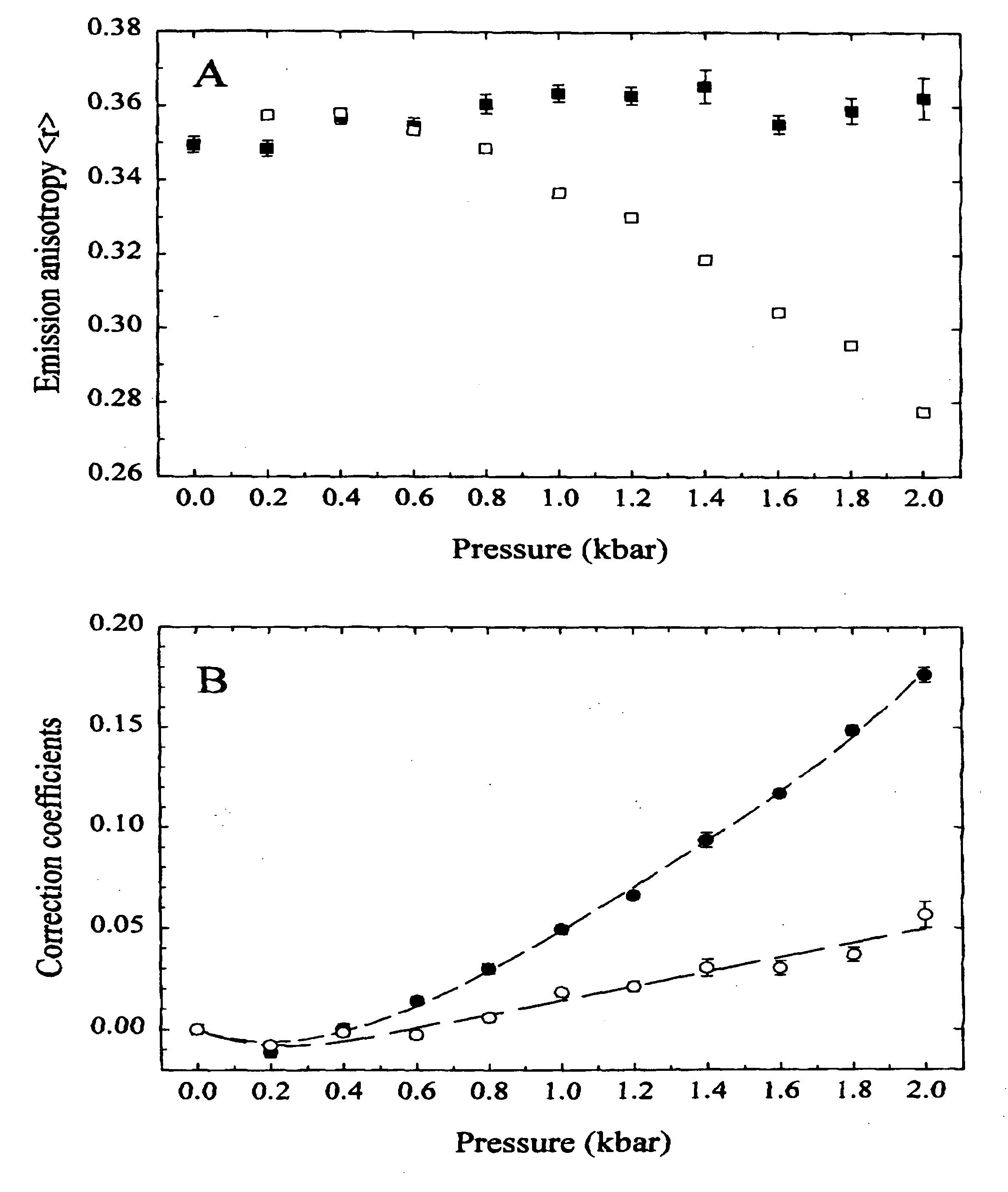Direct method for the correction of pressure induced scrambling of polarized fluorescence intensities
a fluorescence intensity and pressure-induced technology, applied in the direction of fluorescence/phosphorescence, optical radiation measurement, instruments, etc., can solve the problems of significant distorted determined values of fluorescence emission anisotropy (ea), inherent scrambling of polarized light, and experimentally challenging approaches
- Summary
- Abstract
- Description
- Claims
- Application Information
AI Technical Summary
Benefits of technology
Problems solved by technology
Method used
Image
Examples
example 1
[0086] The present method of correction has been tested for common fluorescent dyes 1,6-diphenyl-1,3,5-hexatriene (DPH) and 9,10-diphenylanthracene (DPA) in glycerol where their rotational behavior is well understood. In addition, the pressure induced>melt=profile for the more complicated biologically relevant system of DPH imbedded within dipalmitoylphosphatidylcholine (DPPC) small unilamellar vesicles (SUVs), has been reexamined.
Materials
[0087] 9,10-Diphenylanthracene (DPA) was purchased from Aldrich Chemical Co. (Milwaukee, Wis.) and 1,6-diphenyl-1,3,5-hexatriene (DPH) was obtained from Molecular Probes, Inc. (Eugene, Oreg.). Both fluorescent dyes were used as supplied. Glycerol (Omnisolv; 99.84%) with UV cut-off of 203 nm, was purchased from EM Science (Gibbstown, N.J.). Absolute ethanol (200 proof; Gold Shield) was supplied by Commercial Solvents Corporation (Terre Haute, Ind.). L-α-dipalmitoylphosphatidylcholine (DPPC) was purchased from Sigma Chemical Company (St Louis, Mi...
example 2
Derivation of Equations
[0109] A.1. Standard Instrument Description: Polarized or partially polarized light may be completely described via a four component Stokes vector (See reference 30, infra.): I=[IMCS]=I·[lmcs]=[<mx2(t)+my2(t)><mx2(t)-my2(t)><2mx(t)my(t)cos δ><2mx(t)my(t)sin δ>](A.1)
where mx and my are amplitudes (with relative phase shift δ) of the electric field in directions x and y, respectively. It is assumed that the x direction lies parallel with the experimental plane and will be referred to as the horizontal (H) component, whereas the y direction, perpendicular to the experimental plane, is assigned as vertical (V). It is also assumed that the absorption and subsequent fluorescence emission of a fluorophore arise exclusively from electric dipole transitions and are not sensitive to any rotations by the electromagnetic field. Furthermore, it is assumed that the fluorescence instrument considered here is equipped wit...
PUM
| Property | Measurement | Unit |
|---|---|---|
| emission wavelength | aaaaa | aaaaa |
| emission wavelength | aaaaa | aaaaa |
| emission wavelength | aaaaa | aaaaa |
Abstract
Description
Claims
Application Information
 Login to View More
Login to View More - R&D
- Intellectual Property
- Life Sciences
- Materials
- Tech Scout
- Unparalleled Data Quality
- Higher Quality Content
- 60% Fewer Hallucinations
Browse by: Latest US Patents, China's latest patents, Technical Efficacy Thesaurus, Application Domain, Technology Topic, Popular Technical Reports.
© 2025 PatSnap. All rights reserved.Legal|Privacy policy|Modern Slavery Act Transparency Statement|Sitemap|About US| Contact US: help@patsnap.com



